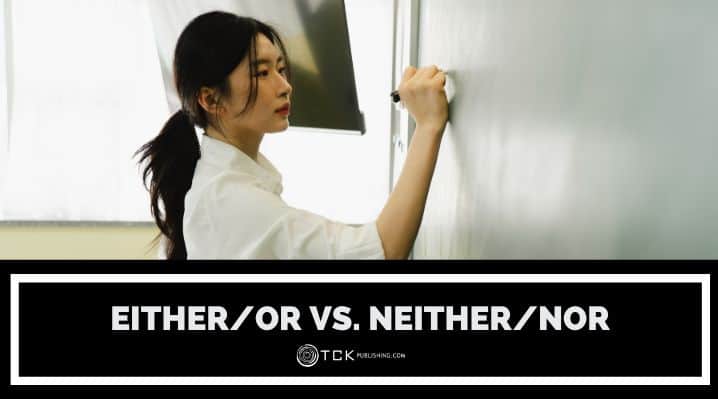
Grammar can be tricky, especially when it comes to pairs like neither/nor and either/or. They look simple, but people often mix them up, leading to confusing or incorrect sentences. Let’s talk about their differences and how you can use them correctly.
What Do They Mean?
Both word pairings are correlative conjunctions. They connect words and phrases within the same part of speech or sentence.
Either/Or
You use either/or when offering a choice between two possibilities. It can be positive or neutral and implies that one option will be chosen.
- You can either have tea or coffee.
- We can either eat now or later.
- Either Mom or Dad will pick me up after school.
Either/or is usually only used when discussing two choices. However, not all agree and you’ll find this rule broken here and there.
Neither/Nor
You use neither/nor when rejecting two options. It’s always negative and shows that neither choice is acceptable or true.
- Neither the dog nor the cat wanted to go outside.
- I speak neither German nor French.
- Neither wind nor rain will stop me from fishing.
You can use neither/nor for more than two options. Simply use nor for every additional choice.
- He can do neither laundry nor cooking nor cleaning.
Here’s a quick comparison of the two:
| Either/Or | Neither/Nor | |
|---|---|---|
| Purpose | Offers a choice. | Rejects or excludes options. |
| Context | Positive or neutral. | Always negative. |
| Verb Agreement | Singular or plural depending on closest subject | Singular or plural depending on closest subject |
As Subject or Object
Both either/or and neither/nor can be used as the subject (performer of the action) or object (receiver of the action) in a sentence.
As Subject
- Either the players or the coaches are responsible.
- Neither the players nor the coaches are responsible.
As Object
- We can speak to either the players or the coaches.
- We spoke to neither the players nor the coaches.
Tips for Both
Here are tips that you can apply to both either/or and neither/nor.
Pair them correctly.
“Either” always goes with “or” and “Neither” always goes with “nor”. A quick way to remember is that either/or both start with vowels while neither/nor both start with consonants.
Make them parallel.
Sometimes, people mistakenly connect two different parts of speech. This creates a parallelism error. You fix this by simply moving the correlative conjunction to the right place.
- Incorrect: You can either partner with John or Stacy. (“Partner with John” is a complete phrase; “Stacy” is only a noun.)
- Correct: You can partner with either John or Stacy. (Both “John” and “Stacy” are simple nouns)
In all cases, what either/or and neither/nor modify should always be grammatically equal (e.g., two nouns, two verb phrases, etc.).
The verb agrees with the closest noun.
When you use either/or and neither/nor with compound subjects, always consider the subject-verb agreement.
- If both nouns are singular, the verb is singular.
- If both nouns are plural, the verb is plural.
- If one noun is singular and one is plural, always consider the noun closest to the verb.
Like so:
- Either the parent or the teacher needs to act.
- Neither the parents nor the teachers saw the incident.
- Either the parent or the teachers are responsible.
Keep the sentence simple.
Simplicity is key when using either/or and neither/nor. Avoid adding too many elements after these pairs to ensure your sentences stay clear. As sentences grow more complex, maintaining proper parallel structure becomes increasingly difficult.
Check the context.
Always use either/or when presenting a choice. In most cases, you can even drop “either” and the sentence’s meaning will remain unchanged. “Either” is used to emphasize that there are only two options and only one can be chosen.
Use neither/nor when both options are negative and you want to emphasize that neither choice is valid or applicable. It’s a way to exclude both options simultaneously.
Avoid double negatives for neither/nor.
Neither/nor already conveys negation. Including another negative creates a grammatical error called a double negative. Double negatives can confuse readers, as they often cancel each other out. You unintentionally create a positive meaning, which is usually not what you intend.
- Incorrect: I don’t want neither the cake nor the pie.
- Correct: I want neither the cake nor the pie.
Conclusion
Mastering neither/nor and either/or doesn’t have to be hard. Remember: one pair offers a choice, and the other rules out options entirely. Either practice using them or construct your sentences without them.
If you’re still unsure of which one to use, run your sentences through Grammarly or ProWritingAid. Grammar checkers like these are fairly accurate in catching and correcting errors with these pairs.
Do you confuse either/or with neither/nor? Share your thoughts below!
If you enjoyed this post, then you might also like:
- Maybe, May Be, and Perhaps: What’s the Correct Way to Use them?
- Be a Grammar Rebel: 9 Grammar Rules You Should Break
- Mastering Punctuation: Definition, Types, and Basic Usage
- Title Case Vs Sentence Case: Which One to Use?

Cole is a blog writer and aspiring novelist. He has a degree in Communications and is an advocate of media and information literacy and responsible media practices. Aside from his interest in technology, crafts, and food, he’s also your typical science fiction and fantasy junkie, spending most of his free time reading through an ever-growing to-be-read list. It’s either that or procrastinating over actually writing his book. Wish him luck!
